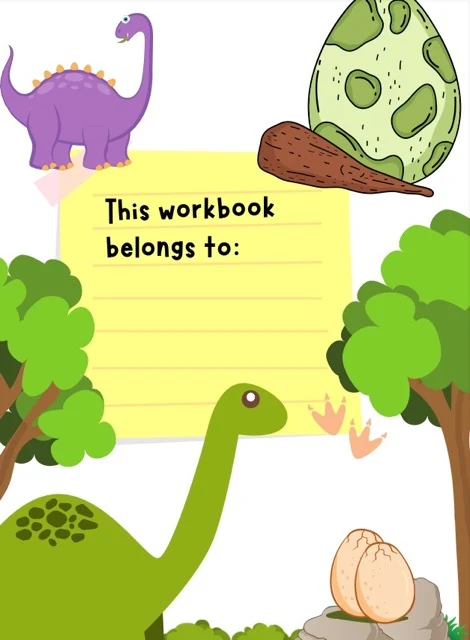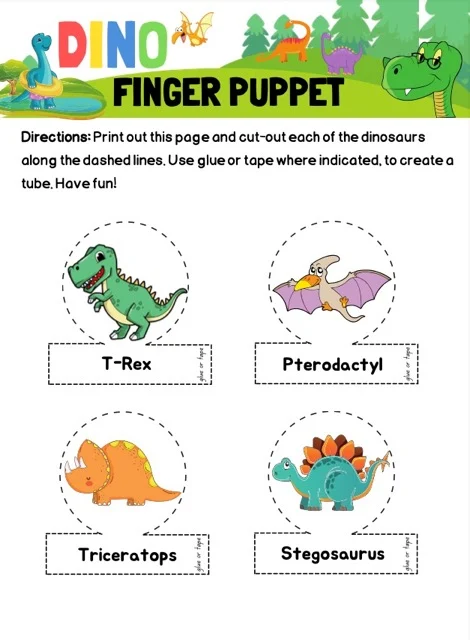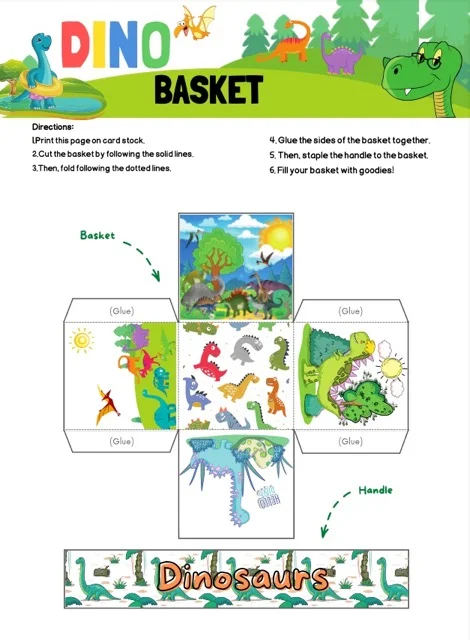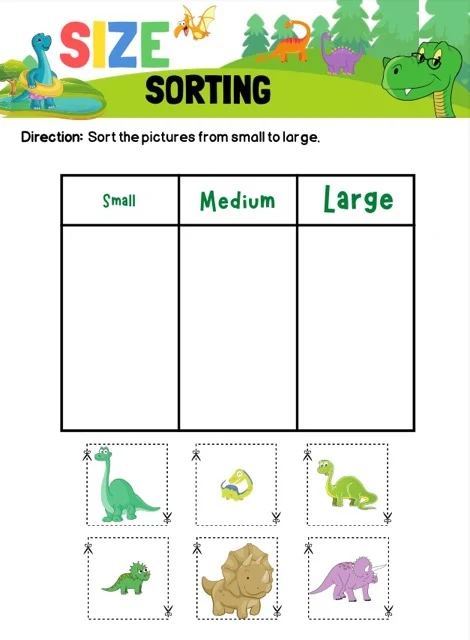Dinosaur Activities for Young Learners
This FAQ sheet details numerous dinosaur-themed activities suitable for preschool and elementary-aged children. The activities, ranging from coloring pages to scavenger hunts, aim to enhance creativity, problem-solving skills, and language development. Furthermore, the guide suggests ways to integrate science concepts like paleontology and evolution into these activities, emphasizing engagement through storytelling and varied materials. Finally, it offers advice on creating original activities and finding additional resources.
Dinosaur Activities for Kids
Dinosaur Activities FAQ
1. What kinds of dinosaur-themed activities are available for kids?
There are many fun and educational dinosaur-themed activities for kids, including:
●
Coloring pages: These pages feature outlines of different dinosaurs that kids can color in.
●
Mazes: Kids can help dinosaurs navigate through a maze to reach their destination.
●
Spot the difference activities: These challenge kids to find the differences between two seemingly identical pictures of dinosaurs.
●
Puzzles: Kids can piece together dinosaur skeletons or match dinosaur names to their corresponding pictures.
●
Syllable counting: Kids can learn about syllables by counting the syllables in different dinosaur names.
●
Nature scavenger hunts: These encourage kids to find dinosaur-related items in nature, such as rocks, leaves, and sticks.
2. What age group are these activities suitable for?
These activities are generally suitable for preschool and elementary school children. The difficulty level of the activities can be adjusted to suit the age and abilities of the child.
3. What are the benefits of dinosaur activities for kids?
Dinosaur activities can offer a range of benefits for kids, including:
●
Developing fine motor skills: Activities such as coloring, cutting, and pasting can help kids improve their hand-eye coordination and fine motor skills.
●
Enhancing creativity: Dinosaur-themed activities can spark kids' imaginations and encourage them to express themselves creatively.
●
Improving problem-solving skills: Puzzles and mazes can help kids develop their logical thinking and problem-solving abilities.
●
Boosting language development: Learning dinosaur names and facts can expand kids' vocabulary and improve their language skills.
●
Fostering a love of learning: Dinosaur activities can make learning fun and engaging, which can encourage kids to explore new topics and develop a lifelong love of learning.
4. How can I use dinosaur activities to teach my child about science?
Dinosaur activities provide a great opportunity to introduce kids to scientific concepts, such as:
●
Paleontology: Explain how scientists study fossils to learn about dinosaurs.
●
Evolution: Discuss how dinosaurs evolved over millions of years.
●
Anatomy: Teach kids about the different parts of a dinosaur's body.
●
Habitats: Explore the different environments where dinosaurs lived.
●
Extinction: Discuss the theories about why dinosaurs went extinct.
5. What are some tips for making dinosaur activities more engaging?
●
Use a variety of activities: Keep things interesting by incorporating different types of activities, such as coloring, puzzles, and games.
●
Incorporate storytelling: Create stories about dinosaurs to make the activities more engaging.
●
Use props: Use dinosaur toys, books, and posters to enhance the learning experience.
●
Take it outside: Go on a nature walk and look for "dinosaur bones" (rocks and sticks).
6. Can I create my own dinosaur activities?
Absolutely! You can easily create your own dinosaur activities using simple materials. For example, you can:
●
Draw your own dinosaur coloring pages.
●
Create a dinosaur-themed scavenger hunt in your backyard.
●
Make dinosaur puppets out of socks or paper bags.
●
Play dinosaur charades or Pictionary.
7. Where can I find more resources for dinosaur activities?
There are many resources available online and in libraries, such as:
●
Educational websites: Websites like National Geographic Kids and PBS Kids offer a wealth of information and activities about dinosaurs.
●
Books: There are countless books about dinosaurs for kids of all ages.
●
Museums: Many museums have dinosaur exhibits that offer interactive learning experiences.
8. Are there any safety considerations when doing dinosaur activities with kids?
●
Supervise young children: Always supervise young children while they are doing dinosaur activities, especially those involving small parts.
●
Use age-appropriate materials: Make sure the materials you use are safe and age-appropriate.
●
Be aware of allergies: Some children may be allergic to materials used in dinosaur activities, such as latex or certain types of paint.
Dinosaur Activities for Kids: A Study Guide
Dinosaur Activities for Kids: A Study Guide
Quiz
Instructions: Answer the following questions in 2-3 sentences each.
1.
What are two benefits of dinosaur activities for children's development?
2.
How can dinosaur activities be used to introduce scientific concepts? Provide two examples.
3.
List three examples of dinosaur-themed activities suitable for preschool and elementary school children.
4.
How can storytelling enhance dinosaur activities for kids?
5.
Suggest two ways to make dinosaur activities more engaging for children.
6.
What is a syllable, and how can dinosaur names be used to teach children about syllables?
7.
Why is it important to supervise young children during dinosaur activities?
8.
Describe a nature scavenger hunt activity with a dinosaur theme.
9.
What are two safety considerations when planning dinosaur activities for kids?
10.
Besides educational websites, where can you find resources for dinosaur activities?
Quiz Answer Key
1.
Dinosaur activities can enhance fine motor skills through activities like coloring and improve language development by introducing new vocabulary like dinosaur names.
2.
Dinosaur activities can introduce concepts like paleontology by explaining how scientists study fossils or evolution by discussing how dinosaurs changed over time.
3.
Three examples of suitable activities include coloring pages, mazes, and spot-the-difference activities.
4.
Storytelling can make dinosaur activities more engaging by creating narratives around the activities, such as a dinosaur escaping a maze or a dinosaur searching for food on a scavenger hunt.
5.
Using a variety of activities like puzzles and games keeps things interesting, and incorporating props like dinosaur toys can enhance the learning experience.
6.
A syllable is a unit of pronunciation with a single vowel sound. Kids can learn about syllables by counting the syllables in different dinosaur names like "Ste-go-saur-us" or "Brach-i-o-saur-us".
7.
Young children need supervision to ensure they don't put small parts in their mouths or engage in activities that might be physically unsafe.
8.
A nature scavenger hunt could involve searching for items that resemble dinosaur features, like sticks for bones, rocks for eggs, and leaves for scales.
9.
Always use age-appropriate materials and supervise children, especially when using small parts. Be mindful of potential allergies to materials like latex or paint.
10.
Other resources for dinosaur activities include books, museums, and libraries.
Essay Questions
1.
Discuss the different ways dinosaur activities can contribute to a child's cognitive, social, and emotional development.
2.
Explain how dinosaur activities can be utilized to integrate various subjects like science, language arts, and mathematics. Provide specific examples.
3.
Analyze the role of creativity and imagination in the effectiveness of dinosaur-themed learning activities. How can educators encourage these aspects?
4.
Critically evaluate the impact of technology on dinosaur activities. Discuss the advantages and disadvantages of using digital resources versus traditional hands-on activities.
5.
Considering the diverse learning styles and needs of children, propose a series of inclusive dinosaur activities that cater to a range of abilities and interests.
Glossary of Key Terms
●
Paleontology: The scientific study of fossils to learn about prehistoric life, including dinosaurs.
●
Evolution: The gradual process of change in living organisms over time, leading to the development of new species.
●
Anatomy: The study of the structure of living organisms, including their bones, muscles, and organs.
●
Habitats: The natural environments where organisms live, including their physical surroundings and other organisms.
●
Extinction: The complete disappearance of a species from Earth.
●
Fine motor skills: The ability to make precise movements with the small muscles in the hands and fingers.
●
Syllable: A unit of pronunciation consisting of a single vowel sound, with or without surrounding consonants.
●
Scavenger hunt: A game where participants search for a list of specific items.
●
Engaging: Capable of capturing and holding attention; interesting and stimulating.
●
Props: Objects used on stage or in a performance to create a desired effect or representation.





























